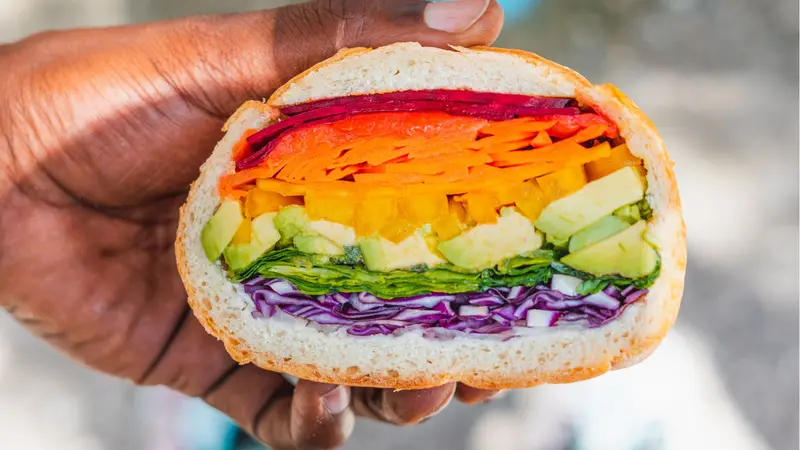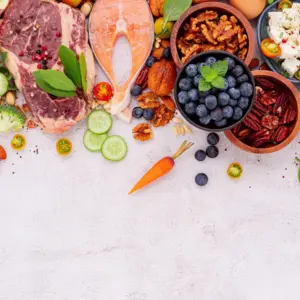
Conscious Eating
Conscious Eating
Hues of Health: Benefits of a Colorful Diet
Eating plant-based foods from every hue in the rainbow provides an exceptional array of health benefits. Rich in essential vitamins, minerals and fiber, vibrantly colored fruits and vegetables also contain phytonutrients such as antioxidants, flavonoids, carotenoids and polyphenols that contribute to the color, flavor and aroma of such foods. There are thousands of phytonutrients, and according to a 2022 review of clinical studies published in Nutrients, these natural chemical compounds “play an important role in the prevention of serious chronic diseases such as diabetes, obesity and hypertension, along with different types of cancer or degenerative diseases.”
From a culinary perspective, colorful, plant-based foods add pops of color and flavor to a dish, and simple techniques can transform uber-nutritious fruits and veggies into crave-worthy delights. From tasty spreads and luscious dressings to pungent pickling recipes and rich soups, eating the rainbow can be a scrumptious and sustainable everyday lifestyle.
Keeping a medley of wholesome choices in the house is a good tactic to help a family adopt a rainbow-based diet. According to Registered Dietitian Olga Kras, “Not any single fruit or vegetable provides all of the nutrients we need. Making a variety of colors of fruits and vegetables visible increases the likelihood that they will be part of a daily routine.”
When her children were younger, instead of giving them sugary treats, she would cut fruits and vegetables into shapes with cookie cutters. “They loved opening their lunch boxes to find the fun shapes,” she recalls, noting the allure of visually pleasing treats. As the first-century Roman Apicius said, “We eat first with our eyes.”
According to Sarah Stegner, co-owner and chef of Prairie Grass Cafe, in Northbrook, Illinois “Food is medicine. It is what lifts us up. When we allow ourselves to get run-down or we are tired, that is when we are the most vulnerable, and we reach for that highly processed, packaged thing. That’s when we compromise, and compromise leads to long-term illness.”
Stegner compares food shopping to a trip to an art store for the artist that is about to paint a rainbow. “Center yourself,” she counsels. “Don’t put anything into the cart that shouldn’t be eaten. The key word is choice. If people don’t understand and realize what the choices they have are—for example, what herbs are and how to use them—then that is not a choice for them when they go home to cook a meal.”
“It’s just fun to have foods that are colorful,” says Erin Hoogendyk, a cooking instructor at Grebe’s Chef Center, in Wausau, Wisconsin, whose favorite flavor accents are onions, lemons and limes, as well as a panoply of herbs, including basil, rosemary, chives, parsley and mint. To add color and nutrition to everyday salads, she tosses in blueberries or dresses them with homemade vinaigrettes made with strawberries and balsamic.
Hoogendyk recommends farmers markets, individual farm stands and community-supported agriculture subscriptions to discover the freshest, in-season ingredients. When it comes to cooking and putting meals together, a sense of adventure and enjoyment is paramount, she says. Her coleslaw recipe includes red and green onions, radishes and red cabbage. “I don’t like coleslaw to be boring,” she quips, adding that her next project is to pickle an ingredient she has never pickled before: celery. “I can’t wait to see how it turns out.”
For those wanting to optimize their rainbow-based diets, “testing can help people understand how to best support their biology and determine what their bodies need,” says Dr. Véronique Desaulniers, a chiropractor and author of Heal Breast Cancer Naturally. She recommends the DNA test kit and whole-body health report from Nutrition Genome to pinpoint which foods to enjoy or avoid, depending on genetic weaknesses. Close monitoring of blood sugar levels is also important, she notes, as daily glucose and insulin spikes “can turn on cancer-causing genes and cancer-causing pathways.”
Veronica Hinke is a food historian and author of The Last Night on the Titanic: Unsinkable Drinking, Dining and Style. Learn more at FoodStringer.com.
Colorful Recipes

Cheesy Cauliflower Mushroom Steaks
This dish can be served as a meal or cut into smaller pieces and presented as party appetizers. Cauliflower provides vitamins B6, K and C, magnesium and fiber. Read More »

Summer Broccoli Soup With Herb Croutons
This vibrant, lime green-colored soup is an excellent source of potassium, fiber, vitamins B6 and C, iron, magnesium and calcium. Read More »

Marinated Beets and Goat Cheese Crostini
Deriving their deep red color from phytonutrients called betalains, beets are rich in nitrates, which help to lower blood pressure. Read More »
Original article published at Natural Awakenings


 By
By



